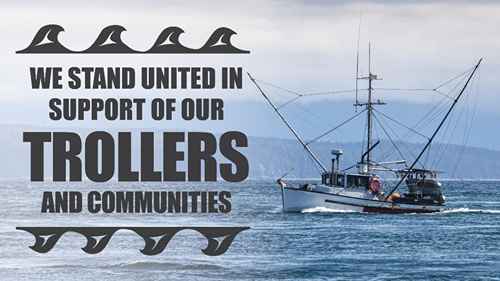
JUNEAU, Alaska – Members of the Alaska Trollers Association are expressing outrage that the Pacific Salmon Commission (PSC) has capped Alaska’s harvest of king salmon this summer at 237,000 fish. With the summer troll season set to begin this week, trollers are caught in a technical dispute among commission members over how many king salmon are expected to return to spawn in rivers along the West Coast.
The Alaska members of the Chinook Technical Committee roundly objected to this year’s estimate, which heightens Alaska fishermen’s concerns about the accuracy of the abundance- based system and the fact that they so often get shortchanged.
“This year’s quota shines a bright light on a treaty agreement that is not working for Southeast Chinook fishermen and communities. For over 30 years trollers have paid the price of habitat destruction in the Pacific Northwest. The stocks we’ve worked hard to rebuild are now returning in record numbers, yet Alaska is being held to a pitifully low quota that fails to recognize that abundance. Trollers are losing faith that they will ever see a fair shake in this process,” said Dale Kelley, executive director of the Alaska Trollers Association.
During the past two years the Columbia River has experienced super-sized runs of king salmon, many of which spend most of their life off the coast of Alaska before returning to the Columbia to spawn. The 2013 and 2014 runs were the largest since 1938 when the first dam was installed on the Columbia. The 2015 forecast predicts the third-largest fall run, and other Columbia River stocks are already making a huge showing, causing fishermen to doubt the validity of the low abundance estimate for Alaska. Fish have been returning to the upper reaches of the Columbia in numbers that far exceed the capacity of available spawning area. Many of these fish are from hatcheries intended to mitigate fishermen for the loss of salmon due to hydropower dams. They are paid for by U.S. citizens, including Alaska fishermen.
“Most Columbia River hatchery fish are paid for by American tax payers and are supposed to provide fish for fishermen and consumers. They create jobs and fuel our economy. I pay my taxes and rely on these fish like every other fisherman on the coast. If we are expected to cut back when the run is weak, why aren’t we entitled to a fair share when it’s strong?” said Steve Merritt, president of the Alaska Trollers Association. Merritt is based out of Craig, Alaska.
In anticipation of the 2014 return, Alaska tried to secure a larger king quota to avoid putting too many fish on the spawning beds, which has been shown to reduce returns of Columbia River king salmon. About 30 percent of Alaska’s harvest is typically comprised of these fish and in recent years that percentage has been higher and includes large numbers of hatchery fish. Despite the enormous return, the other U.S. commissioners (from Oregon and Washington and the Tribes) denied Alaska’s request and the fish surplus ended up so large in 2014 that tens of thousands of unspawned hatchery kings were wasted.
“Alaska’s treaty team has worked hard to secure improvements to the model and have a long history of accurately predicting abundance – we are behind them 100 percent. We have no preconceived notion about what the quota should be this year. All our fleet wants is a scientifically defensible number that cares for the resource and provides a fair harvest share. Sadly, some folks to the south would rather destroy these magnificent fish by letting five times the escapement goal return to a drought-stricken river rather than see one more of them taken by Alaska fishermen,” said Kelley.
“I’m tired of being treated like a pirate by people who think these fish belong only to them. Columbia River kings spent a year in the river, or in a tank eating fish food we all pay for. Then they come to Alaska and spent three to four years eating our baitfish. It’s just wrong to use faulty data to cheat Alaskans out of our share,” said Casey Mapes, a troller from Yakutat, Alaska.
The Pacific Salmon Treaty was signed in 1985 with the goal of rebuilding salmon runs from Oregon to Alaska and distributing the benefits amongst all West Coast fishermen. At treaty signing, many stocks were significantly depressed. Today, the stocks that migrate to Alaska are largely considered rebuilt. Alaska fishermen are frustrated and angry that this year’s quota is nearly 30,000 fish under Alaska’s original rebuilding quota of 263,000.
“Last year’s quota for Alaska was nearly 440,000 king salmon. We are fishing the same group of fish and Washington is forecasting the third largest run to the Columbia since the dams went in and many other stocks are similarly robust. You tell me how this year’s quota could have dropped by 200,000 fish. It makes absolutely no sense,” said Kelley.
Kelley further stated that, “It’s unconscionable for the PSC to allow this number to stand. The model underpins the entire Chinook agreement and it is seriously malfunctioning to the detriment of Alaska and probably Canada. Not only is this yet another broken treaty promise, but it puts at risk the health of our industry and regional communities. The Chinook Technical Committee should be put back to work immediately, to right what’s wrong here and get a more realistic handle on the quota before our season is over.”
“The next generation of trollers is just beginning to take the reins of the fishery. It’s an exciting time and there is lots of optimism on the docks, particularly with these big runs of fish. It’s just wrong to stifle such hope with bad science and politics!”, said Kelley.






